Capital Cost Consultants Ltd: Managing People in Organisations Report
VerifiedAdded on 2020/10/22
|12
|3235
|257
Report
AI Summary
This report delves into the core aspects of managing people within organizations, using Capital Cost Consultants Ltd as a case study. It meticulously examines the recruitment and selection process, outlining the steps from job vacancy establishment to candidate appointment. The report further explores induction and training programs, highlighting their significance for employee productivity and integration. It also analyzes various motivational theories, including Maslow's Hierarchy of Needs and Herzberg's Two-Factor Theory, and their application in fostering employee engagement. Finally, the report investigates factors influencing individual behavior and effective teamwork within the workplace, providing a comprehensive overview of people management strategies.
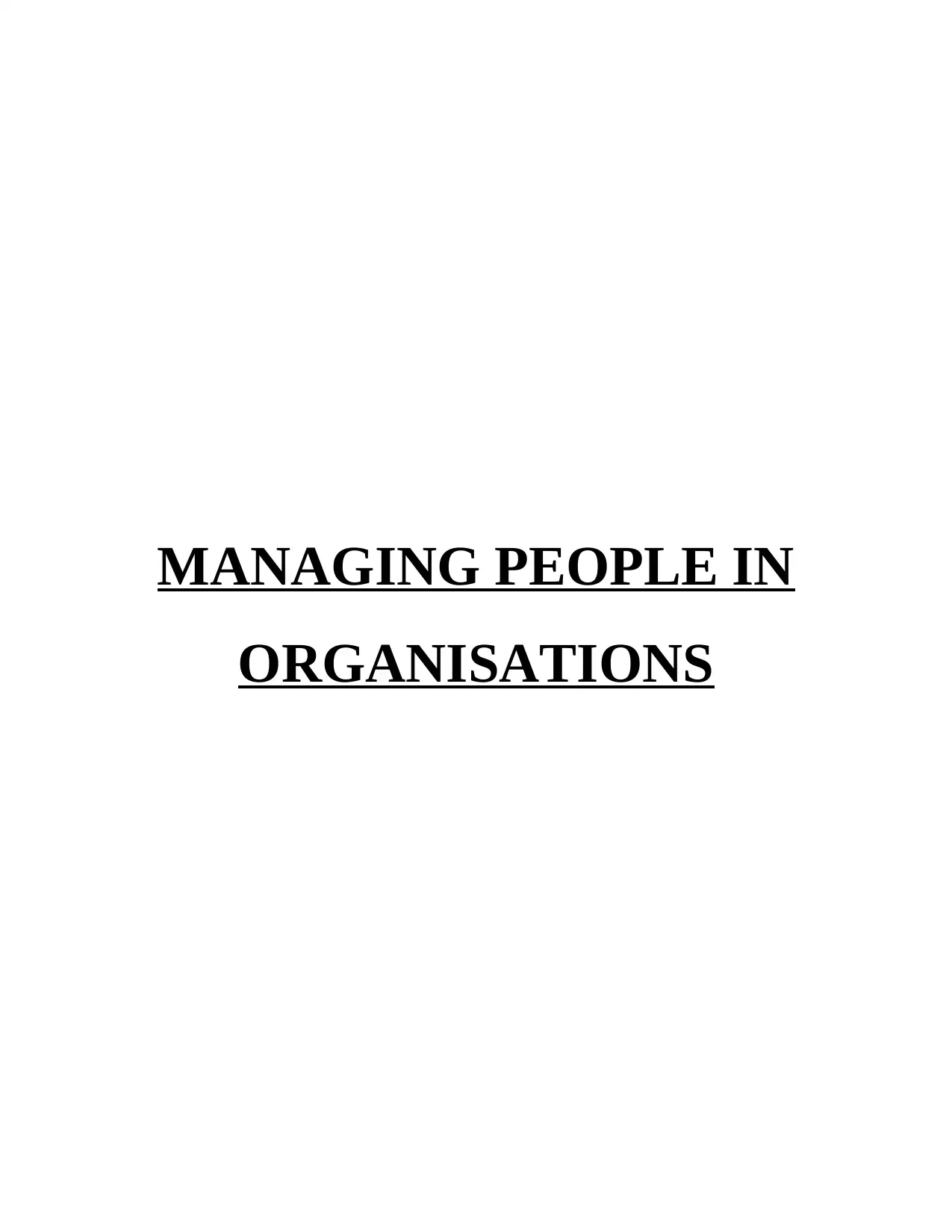
MANAGING PEOPLE IN
ORGANISATIONS
ORGANISATIONS
Paraphrase This Document
Need a fresh take? Get an instant paraphrase of this document with our AI Paraphraser

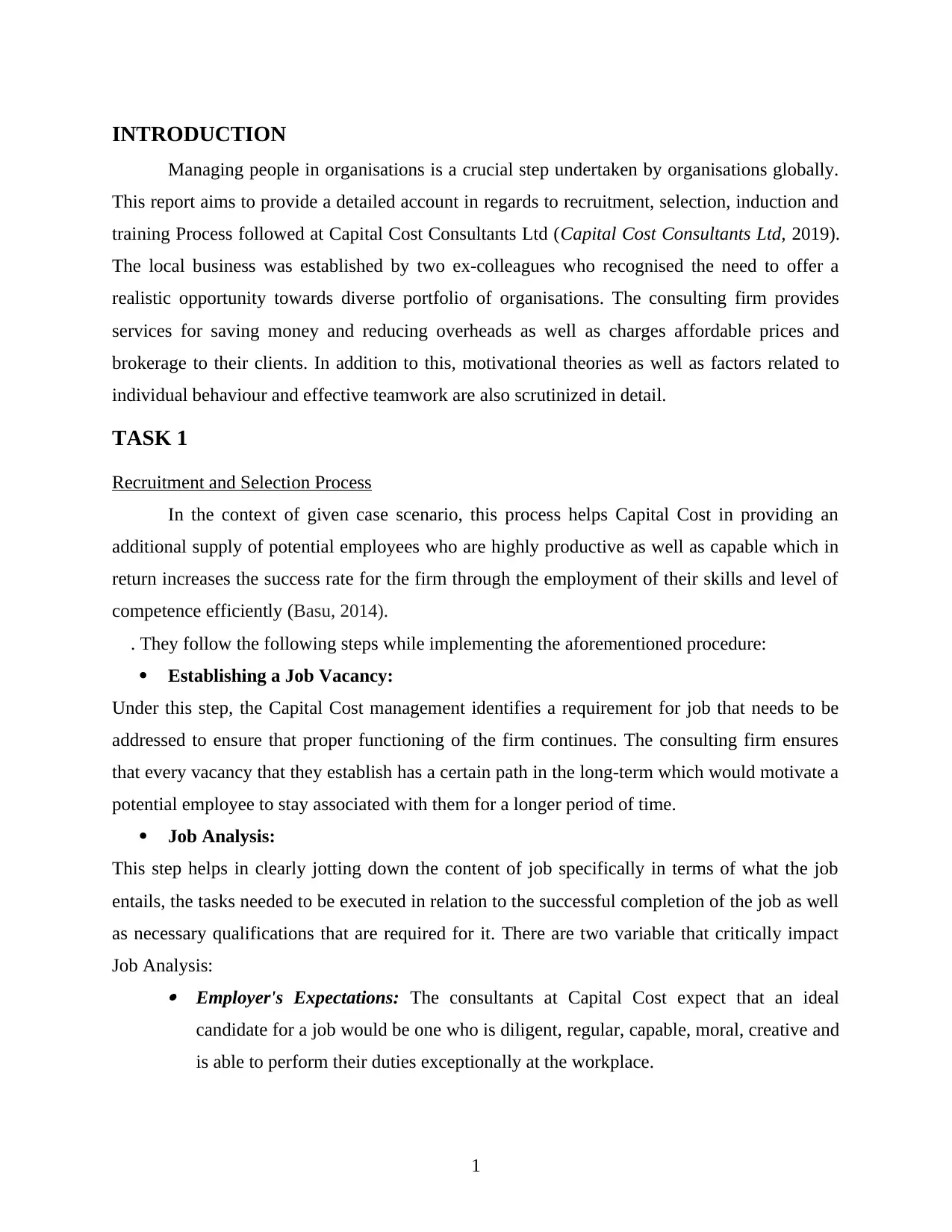
INTRODUCTION
Managing people in organisations is a crucial step undertaken by organisations globally.
This report aims to provide a detailed account in regards to recruitment, selection, induction and
training Process followed at Capital Cost Consultants Ltd (Capital Cost Consultants Ltd, 2019).
The local business was established by two ex-colleagues who recognised the need to offer a
realistic opportunity towards diverse portfolio of organisations. The consulting firm provides
services for saving money and reducing overheads as well as charges affordable prices and
brokerage to their clients. In addition to this, motivational theories as well as factors related to
individual behaviour and effective teamwork are also scrutinized in detail.
TASK 1
Recruitment and Selection Process
In the context of given case scenario, this process helps Capital Cost in providing an
additional supply of potential employees who are highly productive as well as capable which in
return increases the success rate for the firm through the employment of their skills and level of
competence efficiently (Basu, 2014).
. They follow the following steps while implementing the aforementioned procedure:
Establishing a Job Vacancy:
Under this step, the Capital Cost management identifies a requirement for job that needs to be
addressed to ensure that proper functioning of the firm continues. The consulting firm ensures
that every vacancy that they establish has a certain path in the long-term which would motivate a
potential employee to stay associated with them for a longer period of time.
Job Analysis:
This step helps in clearly jotting down the content of job specifically in terms of what the job
entails, the tasks needed to be executed in relation to the successful completion of the job as well
as necessary qualifications that are required for it. There are two variable that critically impact
Job Analysis:
Employer's Expectations: The consultants at Capital Cost expect that an ideal
candidate for a job would be one who is diligent, regular, capable, moral, creative and
is able to perform their duties exceptionally at the workplace.
1
Managing people in organisations is a crucial step undertaken by organisations globally.
This report aims to provide a detailed account in regards to recruitment, selection, induction and
training Process followed at Capital Cost Consultants Ltd (Capital Cost Consultants Ltd, 2019).
The local business was established by two ex-colleagues who recognised the need to offer a
realistic opportunity towards diverse portfolio of organisations. The consulting firm provides
services for saving money and reducing overheads as well as charges affordable prices and
brokerage to their clients. In addition to this, motivational theories as well as factors related to
individual behaviour and effective teamwork are also scrutinized in detail.
TASK 1
Recruitment and Selection Process
In the context of given case scenario, this process helps Capital Cost in providing an
additional supply of potential employees who are highly productive as well as capable which in
return increases the success rate for the firm through the employment of their skills and level of
competence efficiently (Basu, 2014).
. They follow the following steps while implementing the aforementioned procedure:
Establishing a Job Vacancy:
Under this step, the Capital Cost management identifies a requirement for job that needs to be
addressed to ensure that proper functioning of the firm continues. The consulting firm ensures
that every vacancy that they establish has a certain path in the long-term which would motivate a
potential employee to stay associated with them for a longer period of time.
Job Analysis:
This step helps in clearly jotting down the content of job specifically in terms of what the job
entails, the tasks needed to be executed in relation to the successful completion of the job as well
as necessary qualifications that are required for it. There are two variable that critically impact
Job Analysis:
Employer's Expectations: The consultants at Capital Cost expect that an ideal
candidate for a job would be one who is diligent, regular, capable, moral, creative and
is able to perform their duties exceptionally at the workplace.
1
⊘ This is a preview!⊘
Do you want full access?
Subscribe today to unlock all pages.

Trusted by 1+ million students worldwide
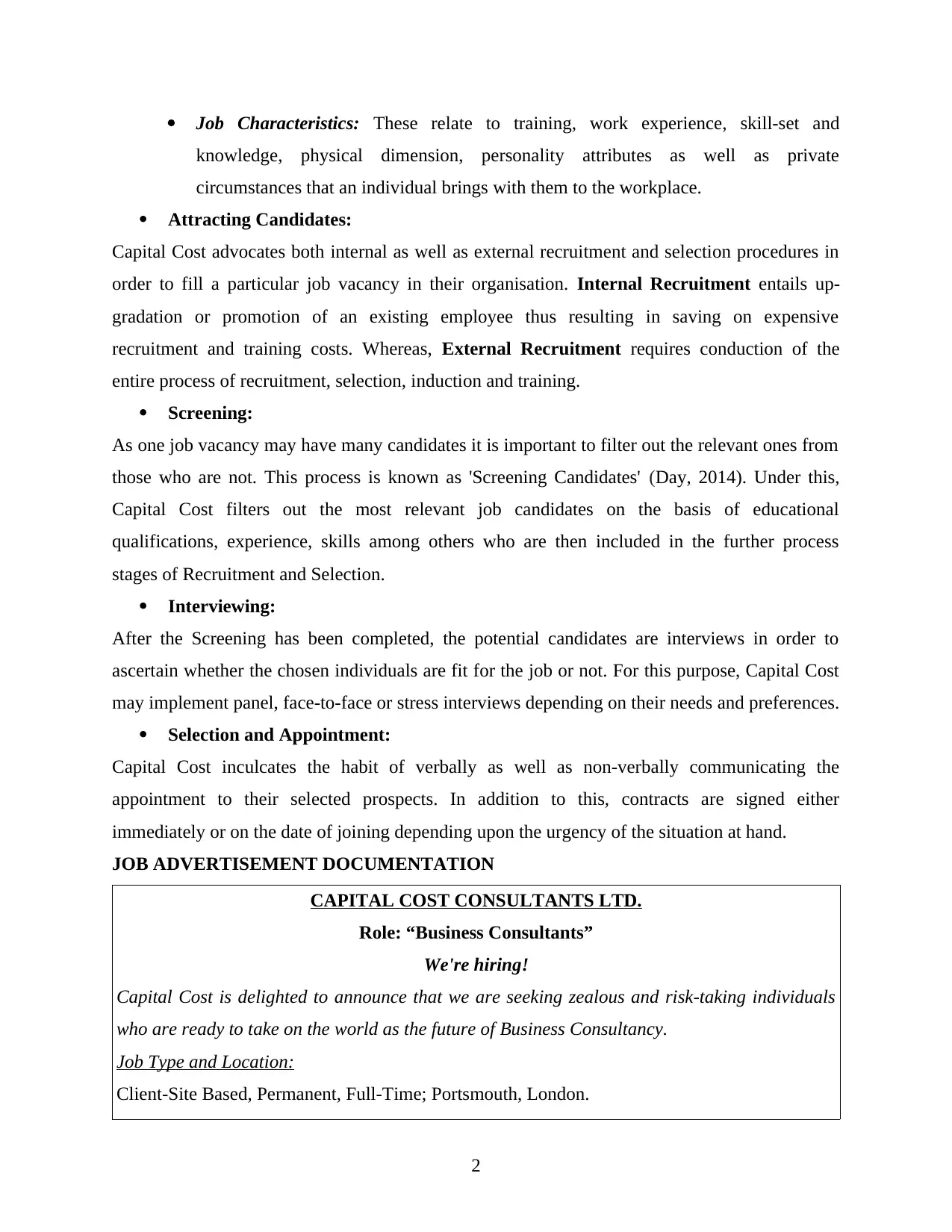
Job Characteristics: These relate to training, work experience, skill-set and
knowledge, physical dimension, personality attributes as well as private
circumstances that an individual brings with them to the workplace.
Attracting Candidates:
Capital Cost advocates both internal as well as external recruitment and selection procedures in
order to fill a particular job vacancy in their organisation. Internal Recruitment entails up-
gradation or promotion of an existing employee thus resulting in saving on expensive
recruitment and training costs. Whereas, External Recruitment requires conduction of the
entire process of recruitment, selection, induction and training.
Screening:
As one job vacancy may have many candidates it is important to filter out the relevant ones from
those who are not. This process is known as 'Screening Candidates' (Day, 2014). Under this,
Capital Cost filters out the most relevant job candidates on the basis of educational
qualifications, experience, skills among others who are then included in the further process
stages of Recruitment and Selection.
Interviewing:
After the Screening has been completed, the potential candidates are interviews in order to
ascertain whether the chosen individuals are fit for the job or not. For this purpose, Capital Cost
may implement panel, face-to-face or stress interviews depending on their needs and preferences.
Selection and Appointment:
Capital Cost inculcates the habit of verbally as well as non-verbally communicating the
appointment to their selected prospects. In addition to this, contracts are signed either
immediately or on the date of joining depending upon the urgency of the situation at hand.
JOB ADVERTISEMENT DOCUMENTATION
CAPITAL COST CONSULTANTS LTD.
Role: “Business Consultants”
We're hiring!
Capital Cost is delighted to announce that we are seeking zealous and risk-taking individuals
who are ready to take on the world as the future of Business Consultancy.
Job Type and Location:
Client-Site Based, Permanent, Full-Time; Portsmouth, London.
2
knowledge, physical dimension, personality attributes as well as private
circumstances that an individual brings with them to the workplace.
Attracting Candidates:
Capital Cost advocates both internal as well as external recruitment and selection procedures in
order to fill a particular job vacancy in their organisation. Internal Recruitment entails up-
gradation or promotion of an existing employee thus resulting in saving on expensive
recruitment and training costs. Whereas, External Recruitment requires conduction of the
entire process of recruitment, selection, induction and training.
Screening:
As one job vacancy may have many candidates it is important to filter out the relevant ones from
those who are not. This process is known as 'Screening Candidates' (Day, 2014). Under this,
Capital Cost filters out the most relevant job candidates on the basis of educational
qualifications, experience, skills among others who are then included in the further process
stages of Recruitment and Selection.
Interviewing:
After the Screening has been completed, the potential candidates are interviews in order to
ascertain whether the chosen individuals are fit for the job or not. For this purpose, Capital Cost
may implement panel, face-to-face or stress interviews depending on their needs and preferences.
Selection and Appointment:
Capital Cost inculcates the habit of verbally as well as non-verbally communicating the
appointment to their selected prospects. In addition to this, contracts are signed either
immediately or on the date of joining depending upon the urgency of the situation at hand.
JOB ADVERTISEMENT DOCUMENTATION
CAPITAL COST CONSULTANTS LTD.
Role: “Business Consultants”
We're hiring!
Capital Cost is delighted to announce that we are seeking zealous and risk-taking individuals
who are ready to take on the world as the future of Business Consultancy.
Job Type and Location:
Client-Site Based, Permanent, Full-Time; Portsmouth, London.
2
Paraphrase This Document
Need a fresh take? Get an instant paraphrase of this document with our AI Paraphraser
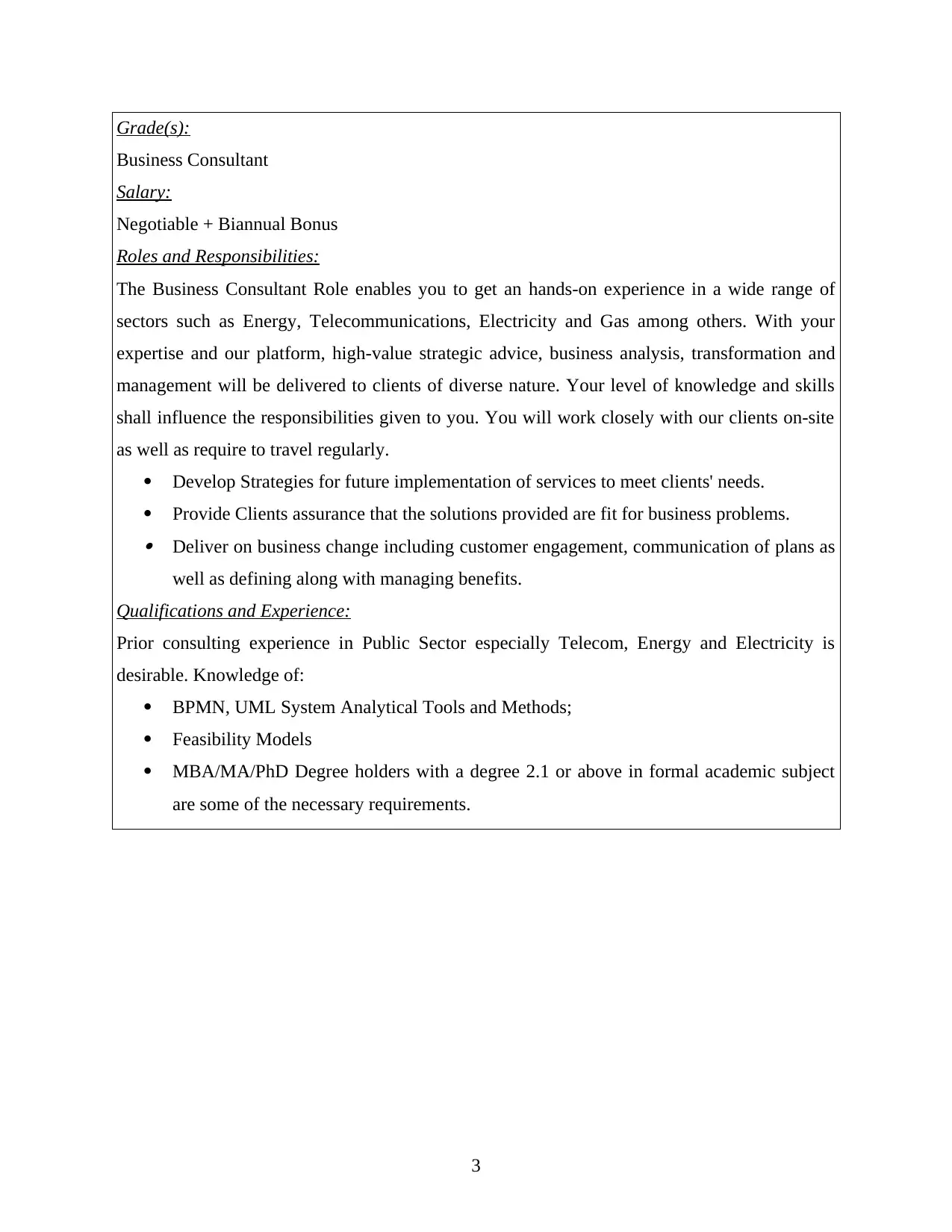
Grade(s):
Business Consultant
Salary:
Negotiable + Biannual Bonus
Roles and Responsibilities:
The Business Consultant Role enables you to get an hands-on experience in a wide range of
sectors such as Energy, Telecommunications, Electricity and Gas among others. With your
expertise and our platform, high-value strategic advice, business analysis, transformation and
management will be delivered to clients of diverse nature. Your level of knowledge and skills
shall influence the responsibilities given to you. You will work closely with our clients on-site
as well as require to travel regularly.
Develop Strategies for future implementation of services to meet clients' needs.
Provide Clients assurance that the solutions provided are fit for business problems. Deliver on business change including customer engagement, communication of plans as
well as defining along with managing benefits.
Qualifications and Experience:
Prior consulting experience in Public Sector especially Telecom, Energy and Electricity is
desirable. Knowledge of:
BPMN, UML System Analytical Tools and Methods;
Feasibility Models
MBA/MA/PhD Degree holders with a degree 2.1 or above in formal academic subject
are some of the necessary requirements.
3
Business Consultant
Salary:
Negotiable + Biannual Bonus
Roles and Responsibilities:
The Business Consultant Role enables you to get an hands-on experience in a wide range of
sectors such as Energy, Telecommunications, Electricity and Gas among others. With your
expertise and our platform, high-value strategic advice, business analysis, transformation and
management will be delivered to clients of diverse nature. Your level of knowledge and skills
shall influence the responsibilities given to you. You will work closely with our clients on-site
as well as require to travel regularly.
Develop Strategies for future implementation of services to meet clients' needs.
Provide Clients assurance that the solutions provided are fit for business problems. Deliver on business change including customer engagement, communication of plans as
well as defining along with managing benefits.
Qualifications and Experience:
Prior consulting experience in Public Sector especially Telecom, Energy and Electricity is
desirable. Knowledge of:
BPMN, UML System Analytical Tools and Methods;
Feasibility Models
MBA/MA/PhD Degree holders with a degree 2.1 or above in formal academic subject
are some of the necessary requirements.
3
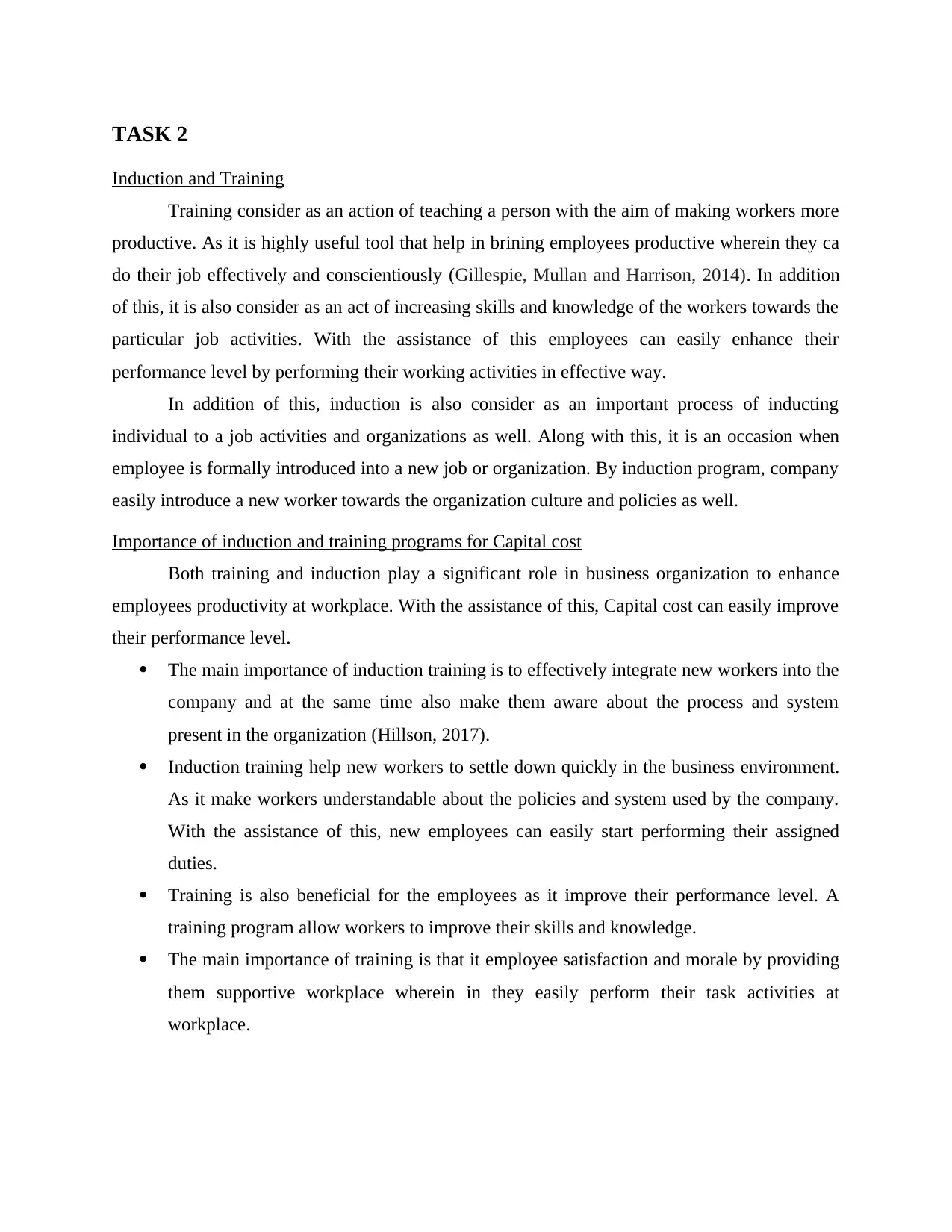
TASK 2
Induction and Training
Training consider as an action of teaching a person with the aim of making workers more
productive. As it is highly useful tool that help in brining employees productive wherein they ca
do their job effectively and conscientiously (Gillespie, Mullan and Harrison, 2014). In addition
of this, it is also consider as an act of increasing skills and knowledge of the workers towards the
particular job activities. With the assistance of this employees can easily enhance their
performance level by performing their working activities in effective way.
In addition of this, induction is also consider as an important process of inducting
individual to a job activities and organizations as well. Along with this, it is an occasion when
employee is formally introduced into a new job or organization. By induction program, company
easily introduce a new worker towards the organization culture and policies as well.
Importance of induction and training programs for Capital cost
Both training and induction play a significant role in business organization to enhance
employees productivity at workplace. With the assistance of this, Capital cost can easily improve
their performance level.
The main importance of induction training is to effectively integrate new workers into the
company and at the same time also make them aware about the process and system
present in the organization (Hillson, 2017).
Induction training help new workers to settle down quickly in the business environment.
As it make workers understandable about the policies and system used by the company.
With the assistance of this, new employees can easily start performing their assigned
duties.
Training is also beneficial for the employees as it improve their performance level. A
training program allow workers to improve their skills and knowledge.
The main importance of training is that it employee satisfaction and morale by providing
them supportive workplace wherein in they easily perform their task activities at
workplace.
Induction and Training
Training consider as an action of teaching a person with the aim of making workers more
productive. As it is highly useful tool that help in brining employees productive wherein they ca
do their job effectively and conscientiously (Gillespie, Mullan and Harrison, 2014). In addition
of this, it is also consider as an act of increasing skills and knowledge of the workers towards the
particular job activities. With the assistance of this employees can easily enhance their
performance level by performing their working activities in effective way.
In addition of this, induction is also consider as an important process of inducting
individual to a job activities and organizations as well. Along with this, it is an occasion when
employee is formally introduced into a new job or organization. By induction program, company
easily introduce a new worker towards the organization culture and policies as well.
Importance of induction and training programs for Capital cost
Both training and induction play a significant role in business organization to enhance
employees productivity at workplace. With the assistance of this, Capital cost can easily improve
their performance level.
The main importance of induction training is to effectively integrate new workers into the
company and at the same time also make them aware about the process and system
present in the organization (Hillson, 2017).
Induction training help new workers to settle down quickly in the business environment.
As it make workers understandable about the policies and system used by the company.
With the assistance of this, new employees can easily start performing their assigned
duties.
Training is also beneficial for the employees as it improve their performance level. A
training program allow workers to improve their skills and knowledge.
The main importance of training is that it employee satisfaction and morale by providing
them supportive workplace wherein in they easily perform their task activities at
workplace.
⊘ This is a preview!⊘
Do you want full access?
Subscribe today to unlock all pages.

Trusted by 1+ million students worldwide
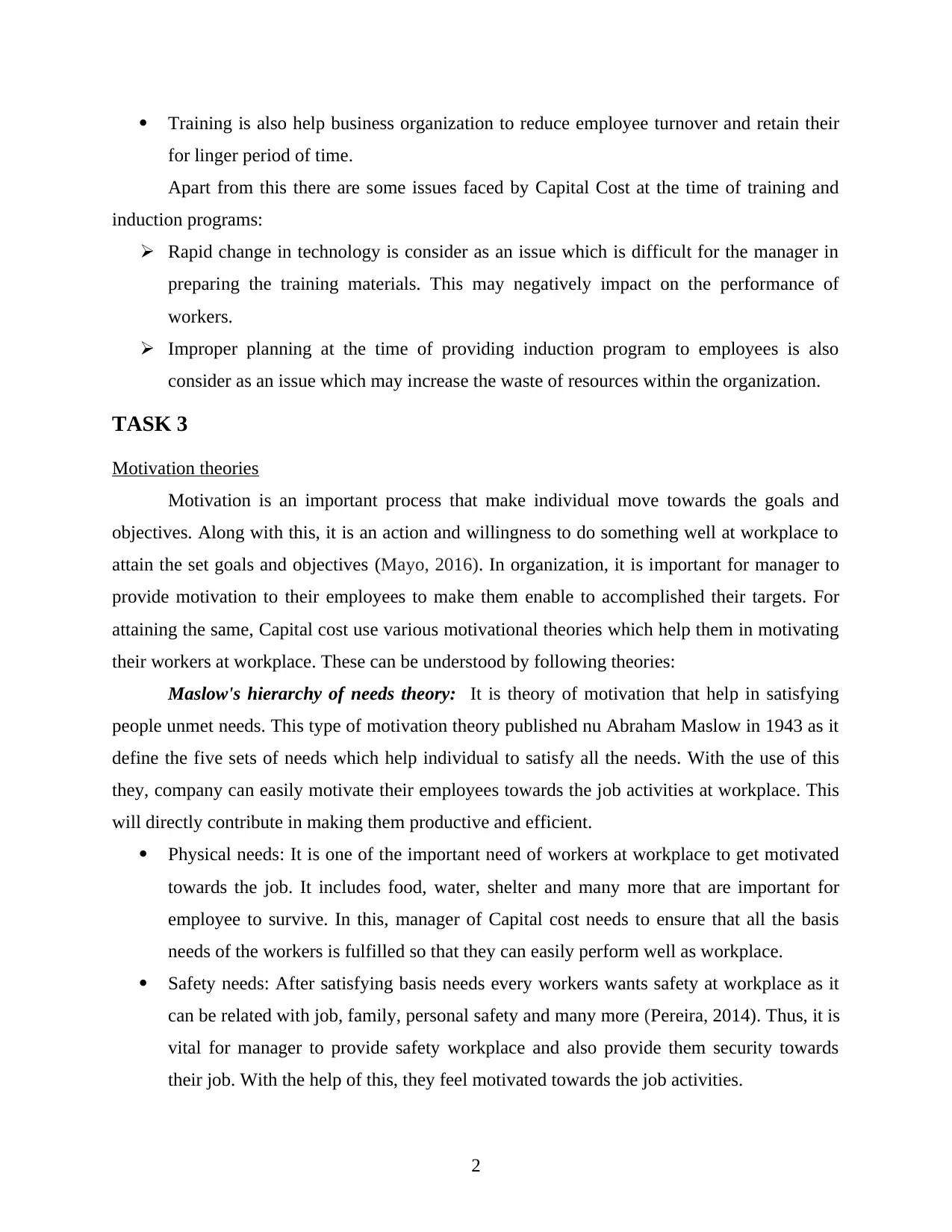
Training is also help business organization to reduce employee turnover and retain their
for linger period of time.
Apart from this there are some issues faced by Capital Cost at the time of training and
induction programs:
Rapid change in technology is consider as an issue which is difficult for the manager in
preparing the training materials. This may negatively impact on the performance of
workers.
Improper planning at the time of providing induction program to employees is also
consider as an issue which may increase the waste of resources within the organization.
TASK 3
Motivation theories
Motivation is an important process that make individual move towards the goals and
objectives. Along with this, it is an action and willingness to do something well at workplace to
attain the set goals and objectives (Mayo, 2016). In organization, it is important for manager to
provide motivation to their employees to make them enable to accomplished their targets. For
attaining the same, Capital cost use various motivational theories which help them in motivating
their workers at workplace. These can be understood by following theories:
Maslow's hierarchy of needs theory: It is theory of motivation that help in satisfying
people unmet needs. This type of motivation theory published nu Abraham Maslow in 1943 as it
define the five sets of needs which help individual to satisfy all the needs. With the use of this
they, company can easily motivate their employees towards the job activities at workplace. This
will directly contribute in making them productive and efficient.
Physical needs: It is one of the important need of workers at workplace to get motivated
towards the job. It includes food, water, shelter and many more that are important for
employee to survive. In this, manager of Capital cost needs to ensure that all the basis
needs of the workers is fulfilled so that they can easily perform well as workplace.
Safety needs: After satisfying basis needs every workers wants safety at workplace as it
can be related with job, family, personal safety and many more (Pereira, 2014). Thus, it is
vital for manager to provide safety workplace and also provide them security towards
their job. With the help of this, they feel motivated towards the job activities.
2
for linger period of time.
Apart from this there are some issues faced by Capital Cost at the time of training and
induction programs:
Rapid change in technology is consider as an issue which is difficult for the manager in
preparing the training materials. This may negatively impact on the performance of
workers.
Improper planning at the time of providing induction program to employees is also
consider as an issue which may increase the waste of resources within the organization.
TASK 3
Motivation theories
Motivation is an important process that make individual move towards the goals and
objectives. Along with this, it is an action and willingness to do something well at workplace to
attain the set goals and objectives (Mayo, 2016). In organization, it is important for manager to
provide motivation to their employees to make them enable to accomplished their targets. For
attaining the same, Capital cost use various motivational theories which help them in motivating
their workers at workplace. These can be understood by following theories:
Maslow's hierarchy of needs theory: It is theory of motivation that help in satisfying
people unmet needs. This type of motivation theory published nu Abraham Maslow in 1943 as it
define the five sets of needs which help individual to satisfy all the needs. With the use of this
they, company can easily motivate their employees towards the job activities at workplace. This
will directly contribute in making them productive and efficient.
Physical needs: It is one of the important need of workers at workplace to get motivated
towards the job. It includes food, water, shelter and many more that are important for
employee to survive. In this, manager of Capital cost needs to ensure that all the basis
needs of the workers is fulfilled so that they can easily perform well as workplace.
Safety needs: After satisfying basis needs every workers wants safety at workplace as it
can be related with job, family, personal safety and many more (Pereira, 2014). Thus, it is
vital for manager to provide safety workplace and also provide them security towards
their job. With the help of this, they feel motivated towards the job activities.
2
Paraphrase This Document
Need a fresh take? Get an instant paraphrase of this document with our AI Paraphraser
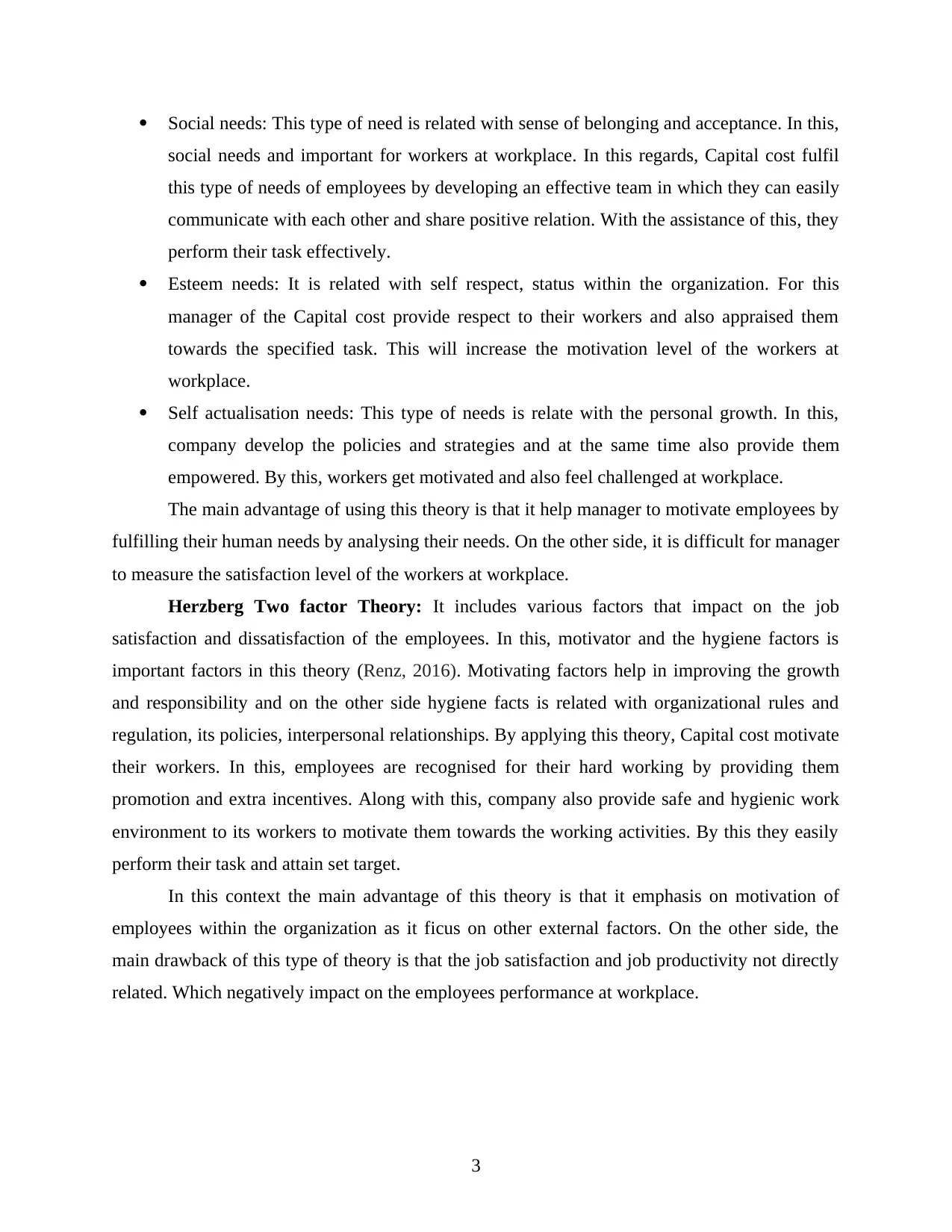
Social needs: This type of need is related with sense of belonging and acceptance. In this,
social needs and important for workers at workplace. In this regards, Capital cost fulfil
this type of needs of employees by developing an effective team in which they can easily
communicate with each other and share positive relation. With the assistance of this, they
perform their task effectively.
Esteem needs: It is related with self respect, status within the organization. For this
manager of the Capital cost provide respect to their workers and also appraised them
towards the specified task. This will increase the motivation level of the workers at
workplace.
Self actualisation needs: This type of needs is relate with the personal growth. In this,
company develop the policies and strategies and at the same time also provide them
empowered. By this, workers get motivated and also feel challenged at workplace.
The main advantage of using this theory is that it help manager to motivate employees by
fulfilling their human needs by analysing their needs. On the other side, it is difficult for manager
to measure the satisfaction level of the workers at workplace.
Herzberg Two factor Theory: It includes various factors that impact on the job
satisfaction and dissatisfaction of the employees. In this, motivator and the hygiene factors is
important factors in this theory (Renz, 2016). Motivating factors help in improving the growth
and responsibility and on the other side hygiene facts is related with organizational rules and
regulation, its policies, interpersonal relationships. By applying this theory, Capital cost motivate
their workers. In this, employees are recognised for their hard working by providing them
promotion and extra incentives. Along with this, company also provide safe and hygienic work
environment to its workers to motivate them towards the working activities. By this they easily
perform their task and attain set target.
In this context the main advantage of this theory is that it emphasis on motivation of
employees within the organization as it ficus on other external factors. On the other side, the
main drawback of this type of theory is that the job satisfaction and job productivity not directly
related. Which negatively impact on the employees performance at workplace.
3
social needs and important for workers at workplace. In this regards, Capital cost fulfil
this type of needs of employees by developing an effective team in which they can easily
communicate with each other and share positive relation. With the assistance of this, they
perform their task effectively.
Esteem needs: It is related with self respect, status within the organization. For this
manager of the Capital cost provide respect to their workers and also appraised them
towards the specified task. This will increase the motivation level of the workers at
workplace.
Self actualisation needs: This type of needs is relate with the personal growth. In this,
company develop the policies and strategies and at the same time also provide them
empowered. By this, workers get motivated and also feel challenged at workplace.
The main advantage of using this theory is that it help manager to motivate employees by
fulfilling their human needs by analysing their needs. On the other side, it is difficult for manager
to measure the satisfaction level of the workers at workplace.
Herzberg Two factor Theory: It includes various factors that impact on the job
satisfaction and dissatisfaction of the employees. In this, motivator and the hygiene factors is
important factors in this theory (Renz, 2016). Motivating factors help in improving the growth
and responsibility and on the other side hygiene facts is related with organizational rules and
regulation, its policies, interpersonal relationships. By applying this theory, Capital cost motivate
their workers. In this, employees are recognised for their hard working by providing them
promotion and extra incentives. Along with this, company also provide safe and hygienic work
environment to its workers to motivate them towards the working activities. By this they easily
perform their task and attain set target.
In this context the main advantage of this theory is that it emphasis on motivation of
employees within the organization as it ficus on other external factors. On the other side, the
main drawback of this type of theory is that the job satisfaction and job productivity not directly
related. Which negatively impact on the employees performance at workplace.
3
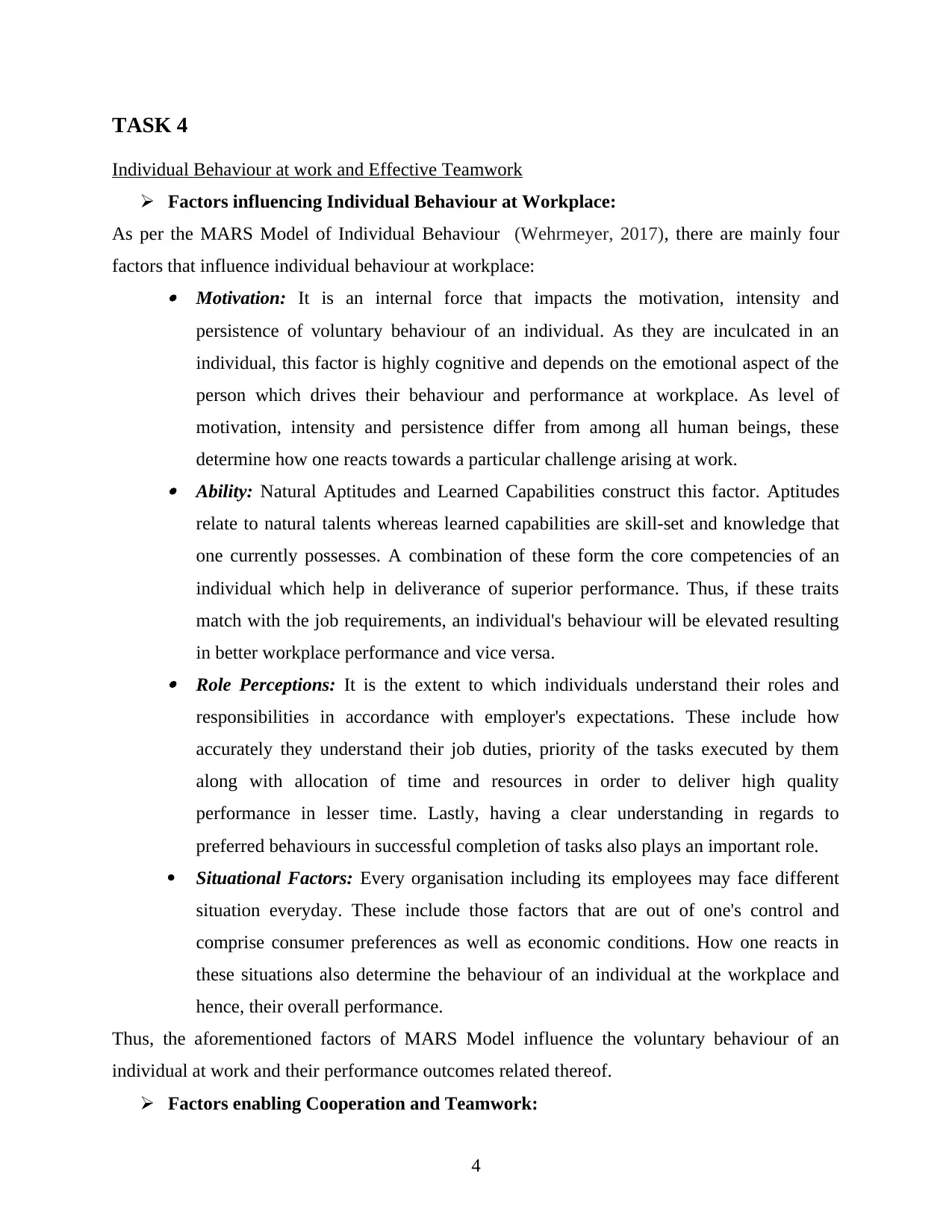
TASK 4
Individual Behaviour at work and Effective Teamwork
Factors influencing Individual Behaviour at Workplace:
As per the MARS Model of Individual Behaviour (Wehrmeyer, 2017), there are mainly four
factors that influence individual behaviour at workplace:
Motivation: It is an internal force that impacts the motivation, intensity and
persistence of voluntary behaviour of an individual. As they are inculcated in an
individual, this factor is highly cognitive and depends on the emotional aspect of the
person which drives their behaviour and performance at workplace. As level of
motivation, intensity and persistence differ from among all human beings, these
determine how one reacts towards a particular challenge arising at work.
Ability: Natural Aptitudes and Learned Capabilities construct this factor. Aptitudes
relate to natural talents whereas learned capabilities are skill-set and knowledge that
one currently possesses. A combination of these form the core competencies of an
individual which help in deliverance of superior performance. Thus, if these traits
match with the job requirements, an individual's behaviour will be elevated resulting
in better workplace performance and vice versa.
Role Perceptions: It is the extent to which individuals understand their roles and
responsibilities in accordance with employer's expectations. These include how
accurately they understand their job duties, priority of the tasks executed by them
along with allocation of time and resources in order to deliver high quality
performance in lesser time. Lastly, having a clear understanding in regards to
preferred behaviours in successful completion of tasks also plays an important role.
Situational Factors: Every organisation including its employees may face different
situation everyday. These include those factors that are out of one's control and
comprise consumer preferences as well as economic conditions. How one reacts in
these situations also determine the behaviour of an individual at the workplace and
hence, their overall performance.
Thus, the aforementioned factors of MARS Model influence the voluntary behaviour of an
individual at work and their performance outcomes related thereof.
Factors enabling Cooperation and Teamwork:
4
Individual Behaviour at work and Effective Teamwork
Factors influencing Individual Behaviour at Workplace:
As per the MARS Model of Individual Behaviour (Wehrmeyer, 2017), there are mainly four
factors that influence individual behaviour at workplace:
Motivation: It is an internal force that impacts the motivation, intensity and
persistence of voluntary behaviour of an individual. As they are inculcated in an
individual, this factor is highly cognitive and depends on the emotional aspect of the
person which drives their behaviour and performance at workplace. As level of
motivation, intensity and persistence differ from among all human beings, these
determine how one reacts towards a particular challenge arising at work.
Ability: Natural Aptitudes and Learned Capabilities construct this factor. Aptitudes
relate to natural talents whereas learned capabilities are skill-set and knowledge that
one currently possesses. A combination of these form the core competencies of an
individual which help in deliverance of superior performance. Thus, if these traits
match with the job requirements, an individual's behaviour will be elevated resulting
in better workplace performance and vice versa.
Role Perceptions: It is the extent to which individuals understand their roles and
responsibilities in accordance with employer's expectations. These include how
accurately they understand their job duties, priority of the tasks executed by them
along with allocation of time and resources in order to deliver high quality
performance in lesser time. Lastly, having a clear understanding in regards to
preferred behaviours in successful completion of tasks also plays an important role.
Situational Factors: Every organisation including its employees may face different
situation everyday. These include those factors that are out of one's control and
comprise consumer preferences as well as economic conditions. How one reacts in
these situations also determine the behaviour of an individual at the workplace and
hence, their overall performance.
Thus, the aforementioned factors of MARS Model influence the voluntary behaviour of an
individual at work and their performance outcomes related thereof.
Factors enabling Cooperation and Teamwork:
4
⊘ This is a preview!⊘
Do you want full access?
Subscribe today to unlock all pages.

Trusted by 1+ million students worldwide
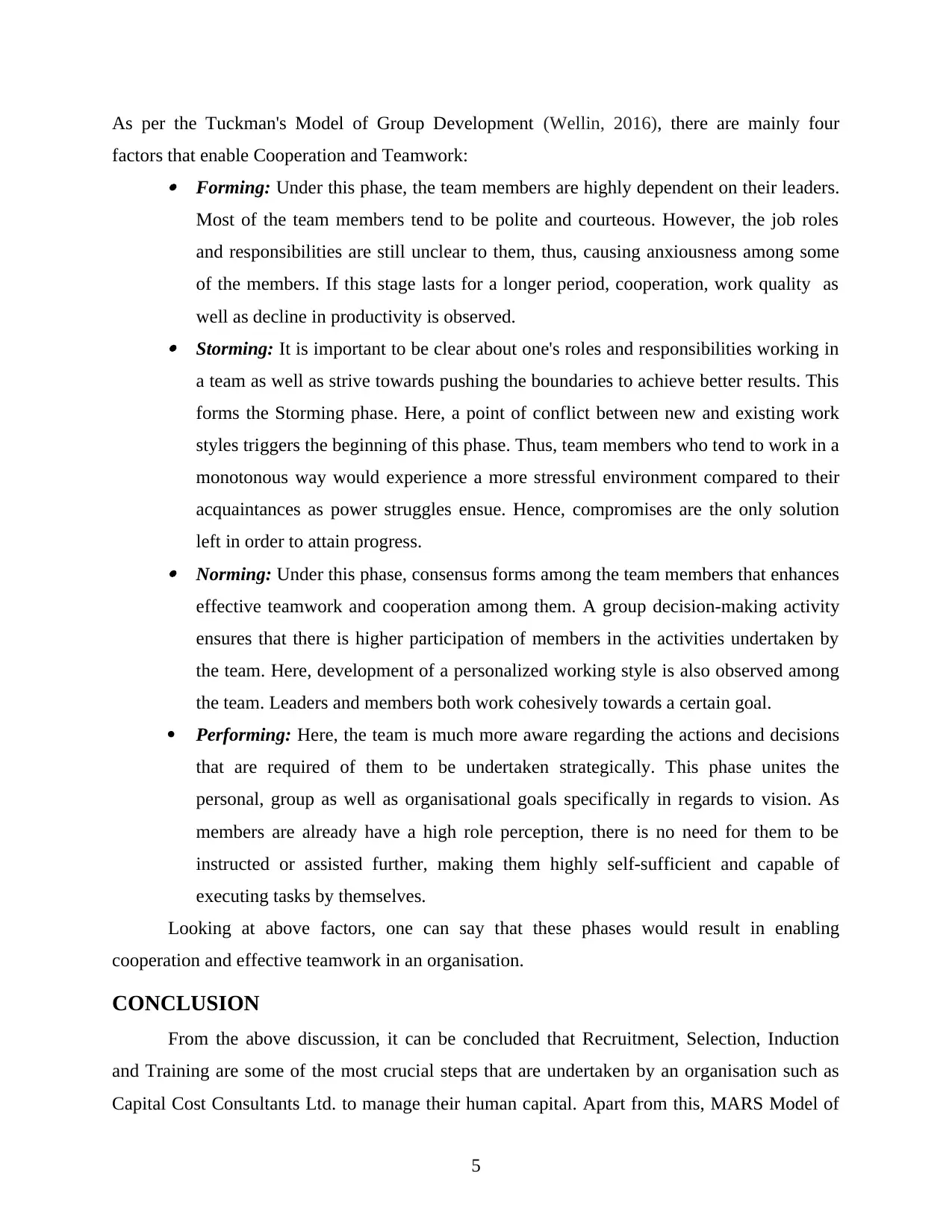
As per the Tuckman's Model of Group Development (Wellin, 2016), there are mainly four
factors that enable Cooperation and Teamwork:
Forming: Under this phase, the team members are highly dependent on their leaders.
Most of the team members tend to be polite and courteous. However, the job roles
and responsibilities are still unclear to them, thus, causing anxiousness among some
of the members. If this stage lasts for a longer period, cooperation, work quality as
well as decline in productivity is observed.
Storming: It is important to be clear about one's roles and responsibilities working in
a team as well as strive towards pushing the boundaries to achieve better results. This
forms the Storming phase. Here, a point of conflict between new and existing work
styles triggers the beginning of this phase. Thus, team members who tend to work in a
monotonous way would experience a more stressful environment compared to their
acquaintances as power struggles ensue. Hence, compromises are the only solution
left in order to attain progress.
Norming: Under this phase, consensus forms among the team members that enhances
effective teamwork and cooperation among them. A group decision-making activity
ensures that there is higher participation of members in the activities undertaken by
the team. Here, development of a personalized working style is also observed among
the team. Leaders and members both work cohesively towards a certain goal.
Performing: Here, the team is much more aware regarding the actions and decisions
that are required of them to be undertaken strategically. This phase unites the
personal, group as well as organisational goals specifically in regards to vision. As
members are already have a high role perception, there is no need for them to be
instructed or assisted further, making them highly self-sufficient and capable of
executing tasks by themselves.
Looking at above factors, one can say that these phases would result in enabling
cooperation and effective teamwork in an organisation.
CONCLUSION
From the above discussion, it can be concluded that Recruitment, Selection, Induction
and Training are some of the most crucial steps that are undertaken by an organisation such as
Capital Cost Consultants Ltd. to manage their human capital. Apart from this, MARS Model of
5
factors that enable Cooperation and Teamwork:
Forming: Under this phase, the team members are highly dependent on their leaders.
Most of the team members tend to be polite and courteous. However, the job roles
and responsibilities are still unclear to them, thus, causing anxiousness among some
of the members. If this stage lasts for a longer period, cooperation, work quality as
well as decline in productivity is observed.
Storming: It is important to be clear about one's roles and responsibilities working in
a team as well as strive towards pushing the boundaries to achieve better results. This
forms the Storming phase. Here, a point of conflict between new and existing work
styles triggers the beginning of this phase. Thus, team members who tend to work in a
monotonous way would experience a more stressful environment compared to their
acquaintances as power struggles ensue. Hence, compromises are the only solution
left in order to attain progress.
Norming: Under this phase, consensus forms among the team members that enhances
effective teamwork and cooperation among them. A group decision-making activity
ensures that there is higher participation of members in the activities undertaken by
the team. Here, development of a personalized working style is also observed among
the team. Leaders and members both work cohesively towards a certain goal.
Performing: Here, the team is much more aware regarding the actions and decisions
that are required of them to be undertaken strategically. This phase unites the
personal, group as well as organisational goals specifically in regards to vision. As
members are already have a high role perception, there is no need for them to be
instructed or assisted further, making them highly self-sufficient and capable of
executing tasks by themselves.
Looking at above factors, one can say that these phases would result in enabling
cooperation and effective teamwork in an organisation.
CONCLUSION
From the above discussion, it can be concluded that Recruitment, Selection, Induction
and Training are some of the most crucial steps that are undertaken by an organisation such as
Capital Cost Consultants Ltd. to manage their human capital. Apart from this, MARS Model of
5
Paraphrase This Document
Need a fresh take? Get an instant paraphrase of this document with our AI Paraphraser

Individual Behaviour helps in analysing how an individual behaves internally as well as
externally. These factors include Motivation, Ability, Role Perception and Situation. On the
other hand, various stages suggested by Tuckman's Model of Group Development in regards to
Forming, Storming, Norming and Performing help in evaluating how teamwork and cooperation
is elevated in the workplace between the leaders and the team members.
6
externally. These factors include Motivation, Ability, Role Perception and Situation. On the
other hand, various stages suggested by Tuckman's Model of Group Development in regards to
Forming, Storming, Norming and Performing help in evaluating how teamwork and cooperation
is elevated in the workplace between the leaders and the team members.
6
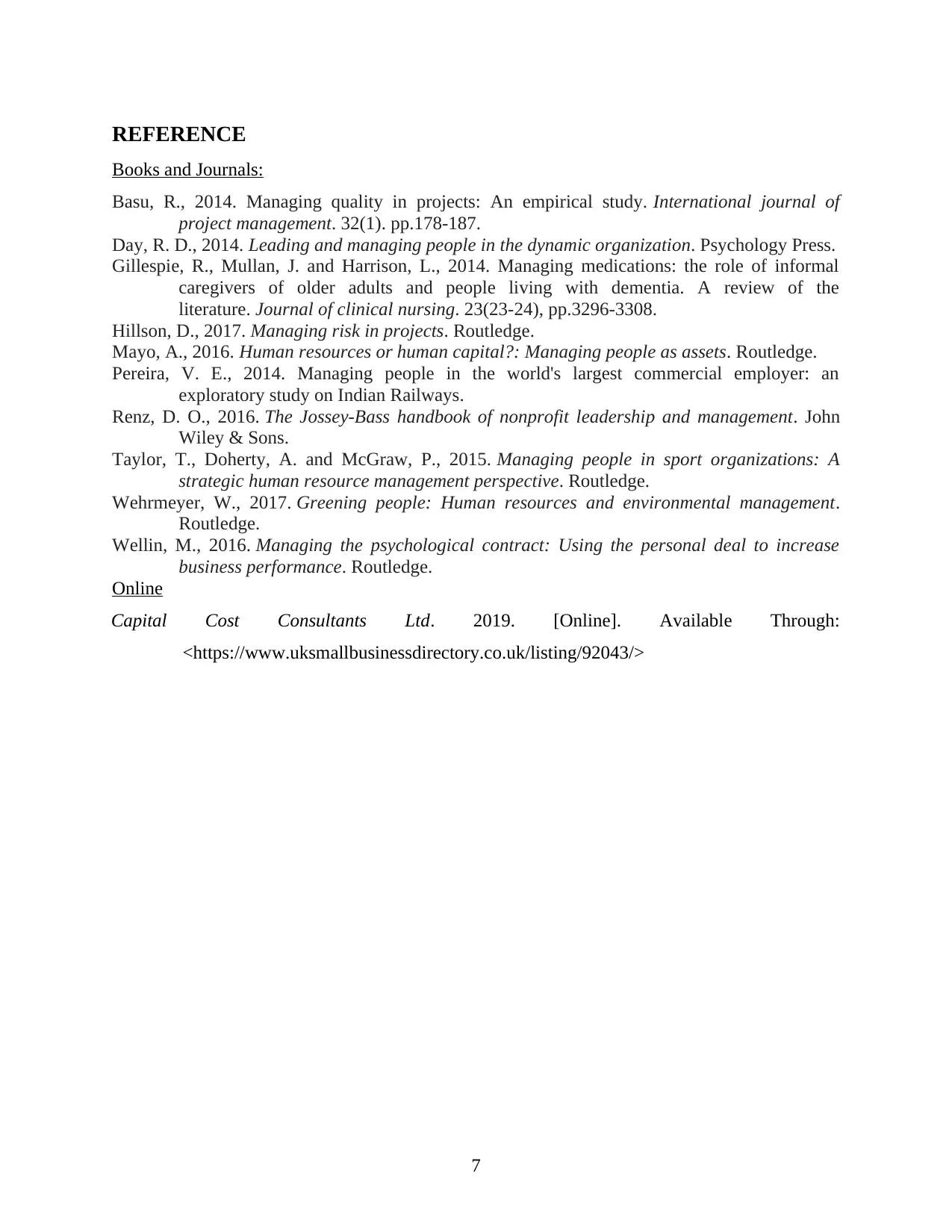
REFERENCE
Books and Journals:
Basu, R., 2014. Managing quality in projects: An empirical study. International journal of
project management. 32(1). pp.178-187.
Day, R. D., 2014. Leading and managing people in the dynamic organization. Psychology Press.
Gillespie, R., Mullan, J. and Harrison, L., 2014. Managing medications: the role of informal
caregivers of older adults and people living with dementia. A review of the
literature. Journal of clinical nursing. 23(23-24), pp.3296-3308.
Hillson, D., 2017. Managing risk in projects. Routledge.
Mayo, A., 2016. Human resources or human capital?: Managing people as assets. Routledge.
Pereira, V. E., 2014. Managing people in the world's largest commercial employer: an
exploratory study on Indian Railways.
Renz, D. O., 2016. The Jossey-Bass handbook of nonprofit leadership and management. John
Wiley & Sons.
Taylor, T., Doherty, A. and McGraw, P., 2015. Managing people in sport organizations: A
strategic human resource management perspective. Routledge.
Wehrmeyer, W., 2017. Greening people: Human resources and environmental management.
Routledge.
Wellin, M., 2016. Managing the psychological contract: Using the personal deal to increase
business performance. Routledge.
Online
Capital Cost Consultants Ltd. 2019. [Online]. Available Through:
<https://www.uksmallbusinessdirectory.co.uk/listing/92043/>
7
Books and Journals:
Basu, R., 2014. Managing quality in projects: An empirical study. International journal of
project management. 32(1). pp.178-187.
Day, R. D., 2014. Leading and managing people in the dynamic organization. Psychology Press.
Gillespie, R., Mullan, J. and Harrison, L., 2014. Managing medications: the role of informal
caregivers of older adults and people living with dementia. A review of the
literature. Journal of clinical nursing. 23(23-24), pp.3296-3308.
Hillson, D., 2017. Managing risk in projects. Routledge.
Mayo, A., 2016. Human resources or human capital?: Managing people as assets. Routledge.
Pereira, V. E., 2014. Managing people in the world's largest commercial employer: an
exploratory study on Indian Railways.
Renz, D. O., 2016. The Jossey-Bass handbook of nonprofit leadership and management. John
Wiley & Sons.
Taylor, T., Doherty, A. and McGraw, P., 2015. Managing people in sport organizations: A
strategic human resource management perspective. Routledge.
Wehrmeyer, W., 2017. Greening people: Human resources and environmental management.
Routledge.
Wellin, M., 2016. Managing the psychological contract: Using the personal deal to increase
business performance. Routledge.
Online
Capital Cost Consultants Ltd. 2019. [Online]. Available Through:
<https://www.uksmallbusinessdirectory.co.uk/listing/92043/>
7
⊘ This is a preview!⊘
Do you want full access?
Subscribe today to unlock all pages.

Trusted by 1+ million students worldwide
1 out of 12
Related Documents
Your All-in-One AI-Powered Toolkit for Academic Success.
+13062052269
info@desklib.com
Available 24*7 on WhatsApp / Email
![[object Object]](/_next/static/media/star-bottom.7253800d.svg)
Unlock your academic potential
Copyright © 2020–2025 A2Z Services. All Rights Reserved. Developed and managed by ZUCOL.



